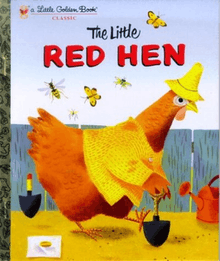The Little Red Hen
The Little Red Hen is an American fable first collected by Mary Mapes Dodge in St. Nicholas Magazine in 1874[1]. The story is meant to teach children the importance of hard work and personal initiative.



The story
A hen living on a farm finds some wheat and decides to make bread with it. She asks the other farmyard animals for help planting it, but they refuse. The hen then harvests and mills the wheat into flour before baking it into bread; at each stage she again asks the animals for help and they refuse. Finally the hen has completed her task and asks who will help her eat the bread. This time the animals accept eagerly, but the hen rebuffs them stating that, just as she made the bread herself, she will eat the bread herself, and runs away with the bread.
Background and adaptations
The tale is based on a story Dodge's mother often told her. Originally the other animals besides the hen consist of a rat, a cat, a dog, a duck, and a pig.[1] Later adaptations often reduce the number of other animals to three.
The story was likely intended as a literature primer for young readers, but departed from highly moralistic, often religious stories written for the same purpose. Adaptations throughout the 1880s incorporated appealing illustrations in order to hold the reader's attention as interest became more relevant to reading lessons. Repetitive vocabulary is still used in adaptations in order to encourage learning for very early readers. A 2006 picture book adaptation by Jerry Pinkney was well-received for similar reasons.
An animated adaptation of the story titled The Wise Little Hen was produced by Walt Disney Productions in 1934. It is notable for the first appearance of Donald Duck as one of the lazy animals who refuse to help the hen.
Revisions
Politically themed revisions of the story include a conservative version based on a 1976 Ronald Reagan monologue. This version features a farmer who claims that the hen is being unfair by refusing to share the bread and forces her to do so, removing the hen's incentive to work and causing poverty to befall the farm.[2] Another version satirizes capitalism by depicting the hen promising the animals slices of bread if they make it, but keeping the largest slice for herself despite not doing any work. A version by Malvina Reynolds adapts the story into a pro-work socialist anthem as the hen retains the fruits of her labor, saying "And that's why they called her Red."[3]
An episode of the animated series Super Why! features a revision of the story. In the episode, the Super Readers change the ending so that the hen tells the animals why she needs their help and they listen, enabling them to help her finish the bread so that she shares it with them.
In popular culture
- The blues song "Little Red Rooster" by Willie Dixon is loosely based on the story. The lazy rooster in the song is the opposite of the industrious hen, being "too lazy to crow for day".
See also
- The Ant and the Grasshopper, an Aesop fable with a similar moral
References
- Mary Mapes Dodge (1874). St. Nicholas. Scribner. pp. 680–.
- "Little Red Hen ~ The Political Spin ~ Quite Amusing!!!". Sodahead.com. Retrieved 2011-12-31.
- "The Little Red Hen".
External links
| Wikimedia Commons has media related to The Little Red Hen. |
- The Little Red Hen: An Old English Folk Tale (HTML version), Retold and Illustrated by Florence White Williams, Saalfield Publishing Company, 1918, available from Project Gutenberg